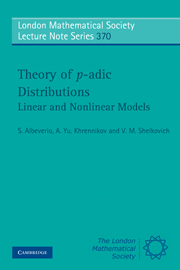Book contents
- Frontmatter
- Contents
- Preface
- 1 p-adic numbers
- 2 p-adic functions
- 3 p-adic integration theory
- 4 p-adic distributions
- 5 Some results from p-adic ℒ1- and ℒ2-theories
- 6 The theory of associated and quasi associated homogeneous p-adic distributions
- 7 p-adic Lizorkin spaces of test functions and distributions
- 8 The theory of p-adic wavelets
- 9 Pseudo-differential operators on the p-adic Lizorkin spaces
- 10 Pseudo-differential equations
- 11 A p-adic Schrödinger-type operator with point interactions
- 12 Distributional asymptotics and p-adic Tauberian theorems
- 13 Asymptotics of the p-adic singular Fourier integrals
- 14 Nonlinear theories of p-adic generalized functions
- A The theory of associated and quasi associated homogeneous real distributions
- B Two identities
- C Proof of a theorem on weak asymptotic expansions
- D One “natural” way to introduce a measure on ℚp
- References
- Index
Preface
Published online by Cambridge University Press: 07 September 2011
- Frontmatter
- Contents
- Preface
- 1 p-adic numbers
- 2 p-adic functions
- 3 p-adic integration theory
- 4 p-adic distributions
- 5 Some results from p-adic ℒ1- and ℒ2-theories
- 6 The theory of associated and quasi associated homogeneous p-adic distributions
- 7 p-adic Lizorkin spaces of test functions and distributions
- 8 The theory of p-adic wavelets
- 9 Pseudo-differential operators on the p-adic Lizorkin spaces
- 10 Pseudo-differential equations
- 11 A p-adic Schrödinger-type operator with point interactions
- 12 Distributional asymptotics and p-adic Tauberian theorems
- 13 Asymptotics of the p-adic singular Fourier integrals
- 14 Nonlinear theories of p-adic generalized functions
- A The theory of associated and quasi associated homogeneous real distributions
- B Two identities
- C Proof of a theorem on weak asymptotic expansions
- D One “natural” way to introduce a measure on ℚp
- References
- Index
Summary
For a few hundred years theoretical physics has been developed on the basis of real and, later, complex numbers. This mathematical model of physical reality survived even in the process of the transition from classical to quantum physics – complex numbers became more important than real, but not essentially more so than in the Fourier analysis which was already being used, e.g., in classical electrodynamics and acoustics. However, in the last 20 years the field of p-adic numbers ℚp (as well as its algebraic extensions, including the field of complex p-adic numbers ℂp) has been intensively used in theoretical and mathematical physics (see [1]–[3], [10]–[15], [24], [35], [38], [43], [44], [55], [64], [65], [77]–[79], [89], [94], [115]–[122], [123], [124], [133], [157], [158], [174], [198], [241]–[246] and the references therein). Thus, notwithstanding the fact that p-adic numbers were only discovered by K. Hensel around the end of the nineteenth century, the theory of p-adic numbers has already penetrated intensively into several areas of mathematics and its applications.
The starting point of applications of p-adic numbers to theoretical physics was an attempt to solve one of the most exciting problems of modern physics, namely, to combine consistently quantum mechanics and gravity, thus to create a theory of quantum gravity. In spite of the considerable success of somemodels, there is still no satisfactory general theory.
Information
- Type
- Chapter
- Information
- Theory of p-adic DistributionsLinear and Nonlinear Models, pp. xi - xviPublisher: Cambridge University PressPrint publication year: 2010
